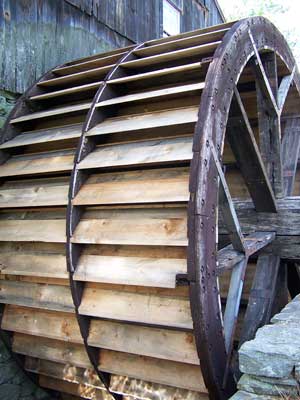This week’s article was written with Jean Pillo, Coordinator for the Thames River Basin Partnership and QSHC Water Quality Monitoring Program, and member of the Woodstock Conservation Commission.
Hydroelectric power, or hydropower, uses free falling water to generate electricity. There are a number of facilities in northeastern CT, including the Toutant (M.S.C) and Putnam Hydropower projects on the Quinebaug River, and the Dayville Pond plant on the Five Mile River. Putnam Green Power recently announced interest in activating a small hydroelectric facility at Cargill Falls.
 Hydropower is not new to the Quiet Corner. In the 1700's, mechanical hydropower waterwheels were used extensively for grinding, milling and pumping. That is why the big mills were usually located next to a river. Modern hydropower technology has come a long way from the waterwheel. Improvements in turbine blade design and other features have reduced the “bass-o-matic” effect, enabling more small fish to survive an accidental ride through a modern plant. Better efficiency at converting the motion of the river to electrical energy enables smaller hydropower stations to operate continually at ‘run of the river’ flows. This reduces the need for pulse/flow systems that periodically hold back water to increase volume and pressure to meet power demands. Some companies are even working on new ‘kinetic’ or ‘free-flow’ hydropower technologies that generate power without a dam or impoundment. Hydropower is not new to the Quiet Corner. In the 1700's, mechanical hydropower waterwheels were used extensively for grinding, milling and pumping. That is why the big mills were usually located next to a river. Modern hydropower technology has come a long way from the waterwheel. Improvements in turbine blade design and other features have reduced the “bass-o-matic” effect, enabling more small fish to survive an accidental ride through a modern plant. Better efficiency at converting the motion of the river to electrical energy enables smaller hydropower stations to operate continually at ‘run of the river’ flows. This reduces the need for pulse/flow systems that periodically hold back water to increase volume and pressure to meet power demands. Some companies are even working on new ‘kinetic’ or ‘free-flow’ hydropower technologies that generate power without a dam or impoundment.
Unlike coal, hydropower does not produce greenhouse gases. Unlike oil, water does not have to be imported from foreign countries. However, because of other environmental impacts, there has been some controversy over whether hydropower is truly a “green” technology. For the most part, small hydropower is considered a sustainable energy source because it relies on a renewable resource (i.e., water, which is not destroyed during the production of electricity), as long as the facility does not cause an appreciable change in river flow. Fish and other aquatic wildlife require water continually, and low flow followed by rapid flushing of their downstream habitat is not a good thing.
Dams can also fragment fish habitat, genetically isolating populations. While it is unlikely that fish that migrate from the sea to spawn were ever able to go farther upstream than Cargill Falls, multiple dams below that point pose barriers to fish migration, and also impact recreational fishing. Fish ladders have been installed in the lower Quinebaug River, opening up more upstream spawning areas, but there are multiple dams on the Quinebaug River and each major tributary streams. While most of these dams do not generate hydropower, all dams withhold and slow down water. The increased solar exposure results in warmer temperatures that do not favor some species of fish like trout. Sediments that used to wash downstream and seasonally replenish floodplains soils instead accumulate behind the dams. Recreational paddlers find dams annoying, especially if there is no easy way to portage around them.
Limitations to significantly increasing hydropower in The Last Green Valley were discussed at a recent Hydropower Summit sponsored by the Rivers Alliance of Connecticut. Charlie Rosenfeld, owner of Putnam Hydropower, said his ‘run of the river’ system was not able to produce electricity for several months due to a lack of rain in 2007. Only small generating systems can be installed on most dams. A fifteen foot drop or more is best to develop adequate ‘head.’ Because the river is a public asset, careful review is required to ensure that a hydropower facility has limited impact on other river functions. The review process for a larger generating facility is arduous and expensive. It can take more than a decade to complete, and often costs several hundred thousand dollars. If a license is granted, it generally is only valid for 30 to 40 years. Despite the cons, hydropower does have the potential to produce more power on a continuous basis than solar or wind if it is located on the right site. |

